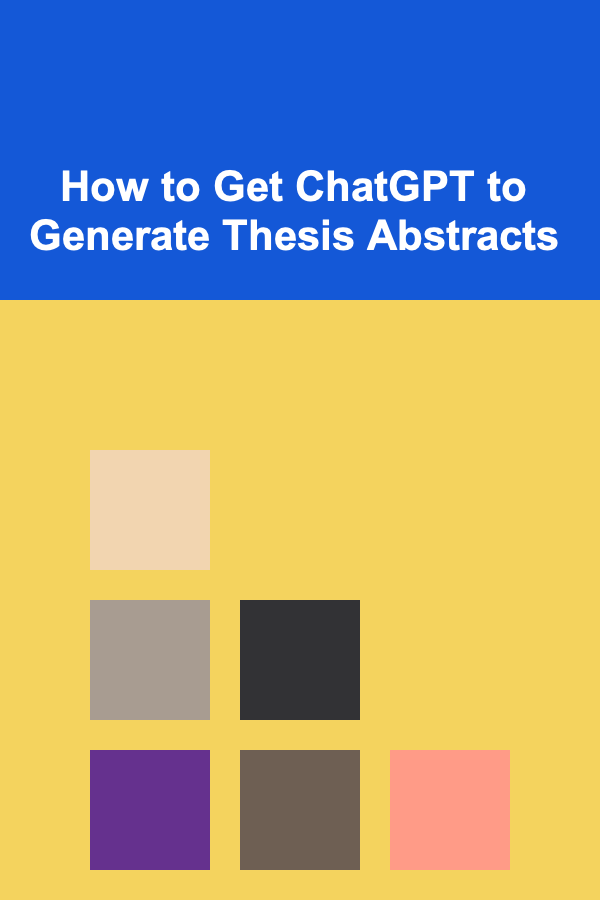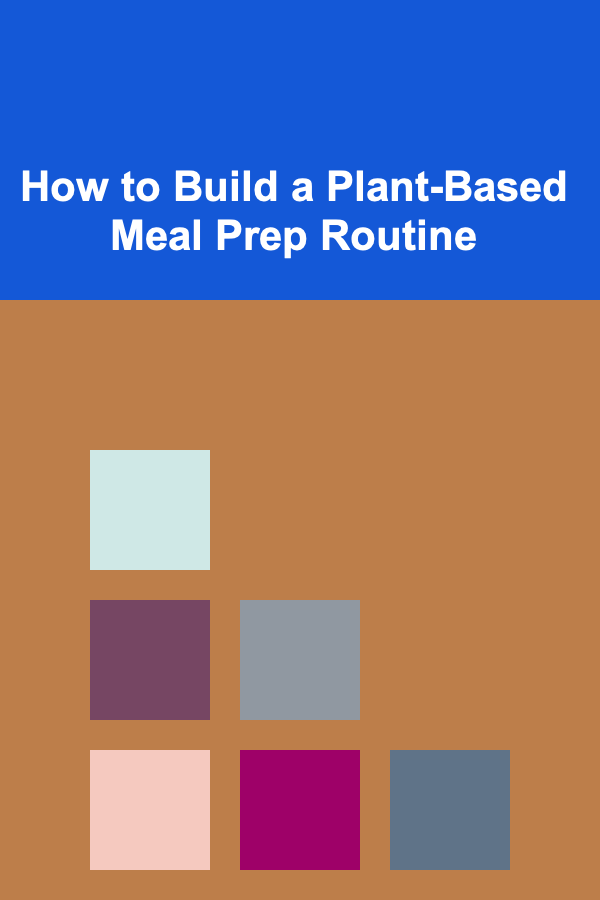
How to Get ChatGPT to Generate Thesis Abstracts
ebook include PDF & Audio bundle (Micro Guide)
$12.99$8.99
Limited Time Offer! Order within the next:

Thesis abstracts are essential components of academic writing, providing a concise summary of a research study's main objectives, methodologies, results, and conclusions. A well-crafted abstract offers readers an understanding of the core content of the thesis, helping them decide whether to engage further with the full document. Given the time and effort required to craft an abstract, many students, researchers, and professionals are looking for ways to streamline the process of generating high-quality abstracts. This is where AI tools like ChatGPT come into play.
ChatGPT, an advanced natural language processing model developed by OpenAI, can assist with a variety of writing tasks, including generating thesis abstracts. In this article, we will explore how to leverage ChatGPT to produce effective and coherent thesis abstracts, guiding you through the process and best practices to ensure that the generated abstract aligns with academic standards.
Understanding the Importance of a Thesis Abstract
Before diving into how ChatGPT can assist with generating thesis abstracts, it is crucial to understand the importance of a well-structured abstract. The abstract serves several key functions:
- Summarizing Key Information: It provides a brief yet comprehensive summary of the entire thesis, highlighting the most important elements of the study.
- Encouraging Further Reading: A compelling abstract can entice readers to explore the full thesis, ensuring that they grasp the value of the research.
- Serving as a Reference: Abstracts are often used in academic databases, research papers, and journal articles, offering an overview of the study for future reference.
A thesis abstract typically includes the following components:
- Objective: The research question or problem being addressed.
- Methods: The approach and techniques used in the research.
- Results: The key findings of the study.
- Conclusion: The implications and significance of the results.
Understanding these components helps in crafting an abstract that effectively conveys the essence of the research.
How ChatGPT Can Help with Thesis Abstract Generation
ChatGPT is capable of generating text that closely mimics human-like writing. It excels at tasks like summarizing content, responding to queries, and producing coherent paragraphs. To generate a thesis abstract, ChatGPT uses prompts, which act as instructions guiding the model in producing the desired output. However, while ChatGPT can assist significantly, it requires proper guidance to produce high-quality and relevant content. Here's how to get the best results.
Step 1: Provide a Clear Research Summary
Before you ask ChatGPT to generate a thesis abstract, ensure that you have a well-defined summary of your research. This summary should include the following:
- Research Problem: A clear explanation of the problem you are addressing.
- Methods: A description of the research methods, such as qualitative or quantitative analysis, case studies, experiments, surveys, etc.
- Findings: A brief overview of your results.
- Conclusions: What your findings mean in the context of the problem.
Providing this information to ChatGPT as input helps the model understand the structure and content of your research, enabling it to generate a coherent and accurate abstract.
For example, a prompt for ChatGPT might look like this:
This prompt is specific enough to guide ChatGPT in producing an abstract that captures the essence of the research.
Step 2: Specify Length and Style
When generating thesis abstracts, it's important to define the length and style. An abstract typically ranges from 150 to 300 words, depending on the specific requirements of the academic institution or publication.
You can instruct ChatGPT to generate the abstract within a specific word count range by including a request in the prompt, such as:
Additionally, specifying the style can help refine the tone and formality of the abstract. Academic writing generally requires a formal and neutral tone, with clear and precise language. If you want ChatGPT to follow this style, you can specify it in your prompt, for example:
By setting these parameters, you ensure that the abstract generated by ChatGPT aligns with academic writing standards.
Step 3: Ask for Iterative Refinements
ChatGPT's ability to produce text in real-time means that you can iterate and refine the abstract. If the first draft does not meet your expectations, you can provide feedback and ask for revisions. For example, you could ask:
- "Can you make the abstract more concise?"
- "Please emphasize the significance of the findings in the conclusion."
- "Rephrase this sentence to sound more academic."
ChatGPT can then adjust its output according to your requests, allowing for multiple drafts and refinements until you achieve the desired result.
Step 4: Adjust for Specific Requirements
In academic settings, different fields may have specific requirements for abstract formats. For example:
- Scientific and technical abstracts: These often focus more on methods and results, using specific terminology related to the field.
- Humanities abstracts: These may focus more on theoretical frameworks and interpretations.
If your thesis belongs to a particular field, you can prompt ChatGPT to tailor the abstract accordingly. For instance:
This way, ChatGPT will align the abstract with the appropriate style and focus.
Step 5: Use ChatGPT for Continuous Improvements
Generating an abstract is not a one-time task. You may need to refine and tweak the abstract over time, especially after revising your thesis or receiving feedback from advisors. By continually using ChatGPT, you can maintain the quality of the abstract throughout the writing process.
Best Practices for Using ChatGPT to Generate Thesis Abstracts
Here are some best practices to follow when using ChatGPT to generate thesis abstracts:
1. Be Specific with Your Prompt
The more specific and detailed your prompt is, the better ChatGPT will perform. A vague prompt may result in a general or irrelevant abstract that doesn't capture the nuances of your research. Clearly outline the study's objectives, methodology, results, and conclusions to help ChatGPT understand what to include.
2. Provide Examples of Well-Written Abstracts
If you have access to high-quality abstract samples in your field, share them with ChatGPT. This will help the model understand the tone, structure, and academic language required. You can provide these as examples in your prompt, like:
3. Review and Revise
Even though ChatGPT is capable of generating impressive abstracts, always review the output to ensure that it accurately reflects your research. You may need to adjust phrasing, remove redundant information, or make the language more concise.
4. Check for Alignment with Thesis Structure
Ensure that the abstract aligns with the structure of your thesis. The abstract should not introduce new information but instead summarize the key points. If ChatGPT generates an abstract that deviates from this structure, politely ask for revisions.
5. Avoid Over-Reliance
While ChatGPT can be an excellent tool for generating abstracts, it's essential to retain your personal involvement in the process. AI-generated content should complement your writing, not replace it. Always add your insights, revisions, and nuances to ensure that the abstract reflects your voice and research accurately.
Conclusion
Using ChatGPT to generate thesis abstracts can significantly streamline the writing process. By providing clear instructions, being specific about your research, and refining the output iteratively, you can leverage this AI tool to produce high-quality abstracts that summarize your research effectively. Remember to review and refine the generated content to ensure it aligns with academic standards and accurately represents your study. With these techniques in hand, you can confidently use ChatGPT to help generate impactful and concise thesis abstracts that will engage readers and encourage further exploration of your work.
Reading More From Our Other Websites
- [Home Lighting 101] How to Choose the Right Lighting for Your Living Room
- [Gardening 101] Vermiculture vs. Traditional Composting: Which Method Suits Your Space?
- [Personal Finance Management 101] How to Evaluate Home Financing Options Effectively
- [Home Holiday Decoration 101] How to Create a DIY Advent Calendar to Decorate Your Home
- [Polymer Clay Modeling Tip 101] Best Polymer Clay Cell Phone Cases: Innovative Designs & Durable Techniques
- [Reading Habit Tip 101] Purpose-Driven Reading: Strategies to Align Your Books with Your Goals
- [Home Soundproofing 101] How to Soundproof Your Townhouse for Privacy and Noise Control
- [Home Budget 101] How to Save Money on Back-to-School Supplies Without Sacrificing Quality
- [Organization Tip 101] The Best Furniture for a Stylish and Functional Boho Bedroom
- [Home Rental Property 101] How to Navigate the Unique Benefits and Challenges of Living in a Duplex for Rent

How to Create a Fun Indoor Scavenger Hunt for the Family
Read More
How to Make Your Home Feel Inviting with Budget Decor
Read More
How to Use Your Memory Keeping Planner for Project Life
Read More
How to Build a Gourmet Food Gift Box That Impresses
Read More10 Tips for Entertainment Budgeting and Expense Tracking
Read More
How to Build a Plant-Based Meal Prep Routine
Read MoreOther Products

How to Create a Fun Indoor Scavenger Hunt for the Family
Read More
How to Make Your Home Feel Inviting with Budget Decor
Read More
How to Use Your Memory Keeping Planner for Project Life
Read More
How to Build a Gourmet Food Gift Box That Impresses
Read More10 Tips for Entertainment Budgeting and Expense Tracking
Read More